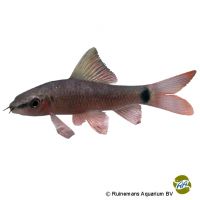Rainbow Shark (Epalzeorhynchos frenatum)
| Rainbow Shark Epalzeorhynchos frenatum | |
|---|---|
| Name | Rainbow Shark |
| Name Lat. | Epalzeorhynchos frenatum |
| Synonym | Labeo frenatus |
| Family | Carps |
| Family lat. | Cyprinidae |
| Order | Carps |
| Order lat. | Cypriniformes |
| Origin | Thailand, Cambodia |
| Habitat | Streams, rivers |
| Diet | Omnivore |
| pH | 6.5-7.5 |
| Behavior | Territorial |
| Keeping | Individual, group |
| Care Level | Moderate |
| Reproduction | Egg scatterer |
| Breeding | None reported |
| Life Span | 6-10 years |
| Protection | No |
| Metric Units | |
| Size | 13-15 cm |
| Temperature | 20-26 °C |
| Hardness | 2-15 °dH |
| Aquarium | ~ 300 l |
| US Units | |
| Size | 5"-6" |
| Temperature | 68-79 °F |
| Hardness | 36-267 ppm |
| Aquarium | ~ 80 gal |
Distribution and habitat
Bridled fringe lippers occur in the Mekong and Chao Phraya River basins (Laos, Thailand, Cambodia). They live in the shallow waters of tributaries and streams as well as in residual water pools and floodplains with tree roots and dead wood.
Maintenance
The aquarium should have a border planting, with numerous hiding places (roots, stones, caves) and a substrate of round gravel and sand covered with some foliage (e.g. sea almond leaves). A slight current is ideal.
No ammonia, ammonium and nitrite should be detectable, the nitrate value should not exceed 100 mg/l. To ensure the water quality and oxygen content, a filter and heater adapted to the aquarium size is required, as well as lighting for the species-appropriate day-night rhythm of the animals.
Diet
They feed mainly on the plant cover (growth) and the microorganisms contained therein, as well as on plankton. The food supply consists of live, frozen and dry food. For a balanced diet, feed once a day with a high-quality dry food (granules, pellets, tabs) as well as cyclops, daphnia, artemia and plankton (live or frozen). In addition, they also need vegetable food, such as algae leaves and commercially available green food (kelp, spirulina)
Only feed as much as will be eaten within a few minutes. A regular and varied diet promotes health and increases resistance.
Behaviour and compatibility
Adults are territorial, but can be socialized without problems, e.g. with larger barbs. Interspecific incompatibility only occurs if they are kept in pairs or threes and do not have sufficient hiding places. Keeping a group is only recommended in a larger and richly structured tank
Basically, only compatible fish species with similar demands on water quality and water temperature may be socialized.
Sex dimorphism
The male has a black fringed anal fin and is more slender
Reproduction and breeding
There are no known reports of successful breeding in the aquarium.
Important
Basically, aquarium plants do not serve them as food.
The well-being of the fish should be checked regularly. The temperature should be checked daily, the pH, hardness and nitrate value at least every 14 days. Regular partial water changes are recommended, even if the contaminant level has not yet reached the upper limit. Sudden changes in water quality should be avoided. Newly introduced fish must be accustomed slowly to the water in the aquarium.
Further literature can be found in your pet store.
References
Text: petdata; Image: Ruinemans Aquarium B.V.
Source: BMEL (1998): Tierschutzgutachten - Haltung von Zierfischen (Süßwasser); BAENSCH & RIEHL (2004): Aquarien Atlas Bd. 2, Mergus Verlag; ENGELMANN (2005): Zootierhaltung - Tiere in menschlicher Obhut: Fische, Verlag Harri Deutsch
- Gemäß § 21 Abs. 5 Tierschutzgesetz idgF
